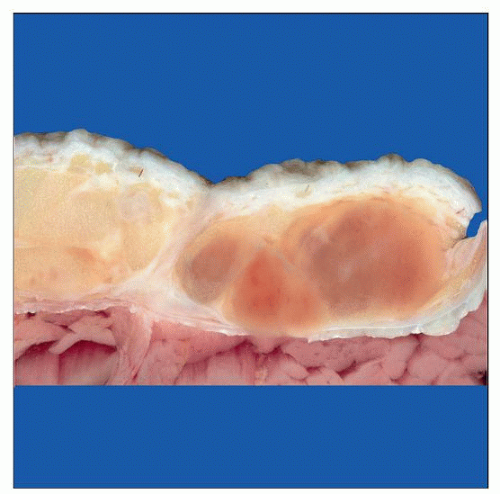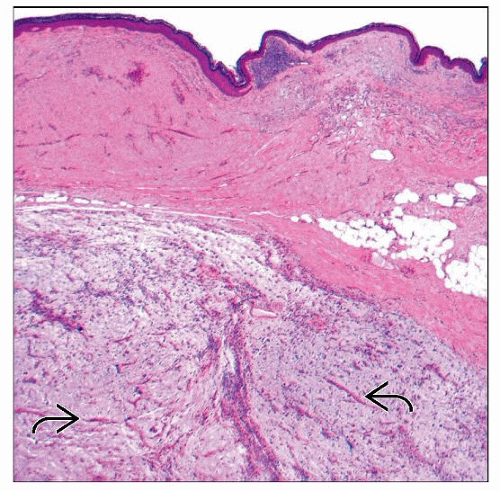Myxofibrosarcoma
David Cassarino, MD, PhD
Key Facts
Terminology
Myxofibrosarcoma represents a spectrum of malignant fibroblastic neoplasms with variably myxoid stroma and characteristic elongated curvilinear vessels
Clinical Issues
One of most common sarcomas in elderly patients
Majority arises in limbs, including limb girdles
Lower > upper extremities
2/3 of cases arise in dermal/subcutaneous tissues
Local, often repeated, recurrences in up to 50-60% of cases (unrelated to histologic grade)
Intermediate- and high-grade malignant neoplasms may develop metastases in 30-35% of cases
Macroscopic Features
Superficially located neoplasms consist of multiple variably gelatinous or firmer nodules
Deep-seated neoplasms often present as single mass with myxoid cut surfaces
Microscopic Pathology
Broad spectrum of cellularity, cytologic atypia, and proliferative activity reflected by 3 grades of malignancy
Multinodular growth, spindled and stellate atypical fibroblastic cells
Myxoid stroma with elongated, curvilinear, thin-walled vessels
Often pseudolipoblasts are present
 Grossly, myxofibrosarcoma often shows a multinodular growth pattern with gelatinous-appearing cut surfaces. (Courtesy T. Mentzel, MD.) |
TERMINOLOGY
Abbreviations
Myxofibrosarcoma (MFS)
Synonyms
Myxoid malignant fibrous histiocytoma (MFH)
Definitions
MFS represents a spectrum of malignant fibroblastic neoplasms with variably myxoid stroma and characteristic elongated curvilinear vessels
CLINICAL ISSUES
Epidemiology
Incidence
One of most common sarcomas in elderly patients
Age
Affects mainly patients in 6th to 8th decade
Exceptionally rare in patients < 20 years old
Gender
Slight male predominance
Site
Majority arise in limbs and limb girdles
Lower > upper extremities
Rarely on trunk, head and neck region
Very rarely on hands and feet
2/3 of cases arise in dermal/subcutaneous tissues
Presentation
Painless mass
Slow growing
Treatment
Surgical approaches
Complete and wide excision
Prognosis
Local, often repeated, recurrences in up to 50-60% of cases (unrelated to histologic grade)
Low-grade MFS usually does not metastasize
Low-grade MFS may show tumor progression in subsequent recurrences
Intermediate- and high-grade MFS may develop metastases in 30-35% of cases
Overall 5-year survival is 60-70%
MACROSCOPIC FEATURES
General Features
Superficially located neoplasms consist of multiple variably gelatinous or firmer nodules
Deep-seated neoplasms often present as single mass with myxoid cut surfaces
Areas of tumor necrosis may be seen in high-grade neoplasms
MICROSCOPIC PATHOLOGY
Stay updated, free articles. Join our Telegram channel

Full access? Get Clinical Tree




